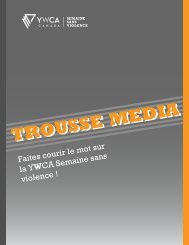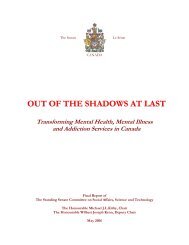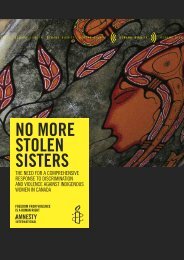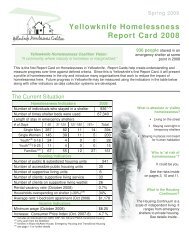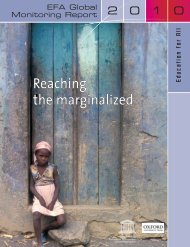Gender Report Card on the International Criminal ... - YWCA Canada
Gender Report Card on the International Criminal ... - YWCA Canada
Gender Report Card on the International Criminal ... - YWCA Canada
Create successful ePaper yourself
Turn your PDF publications into a flip-book with our unique Google optimized e-Paper software.
Structures & Instituti<strong>on</strong>al Development Structures<br />
Overview of Trends CONTINUED<br />
The number of women judges <strong>on</strong> <strong>the</strong> bench<br />
is <strong>the</strong> same as in 2010. Of <strong>the</strong> 19 judges currently<br />
serving at <strong>the</strong> ICC, 11 are women. The electi<strong>on</strong><br />
of new judges, to replace <strong>the</strong> six judges whose<br />
terms are finishing in March 2012, will be held<br />
during <strong>the</strong> tenth sessi<strong>on</strong> of <strong>the</strong> Assembly of<br />
States Parties from 12 to 21 December 2011<br />
in New York. Of <strong>the</strong> judges whose terms will<br />
come to completi<strong>on</strong> in 2012, three are women<br />
(Judge Diarra - Mali, Judge Odio Benito - Costa<br />
Rica, and Judge Steiner - Brazil). The nominati<strong>on</strong><br />
period for judicial candidates opened <strong>on</strong> 13<br />
June and closed <strong>on</strong> 16 September 2011. Of <strong>the</strong><br />
19 judicial nominees, <strong>on</strong>ly two are women of<br />
whom <strong>on</strong>e is from <strong>the</strong> Group of Latin America<br />
and <strong>the</strong> Caribbean regi<strong>on</strong> (Olga Venecia Guerrera<br />
Carbuccia – Dominican Republic) and <strong>on</strong>e from<br />
<strong>the</strong> Asia regi<strong>on</strong> (Miriam Defensor-Santiago – <strong>the</strong><br />
Philippines).<br />
Am<strong>on</strong>g <strong>the</strong> judicial staff <strong>the</strong>re are currently<br />
22% more women than men (61% women, 39%<br />
men) in professi<strong>on</strong>al posts. Women are largely<br />
in <strong>the</strong> P2 and P3 level positi<strong>on</strong>s. Although <strong>the</strong><br />
overall figures show a str<strong>on</strong>g representati<strong>on</strong><br />
of women, <strong>the</strong>re are twice as many men than<br />
women at both <strong>the</strong> P4 and P5 grades. There are<br />
no P1 positi<strong>on</strong>s in <strong>the</strong> Judiciary.<br />
The number of women employed in<br />
professi<strong>on</strong>al posts within <strong>the</strong> OTP decreased<br />
by 3% from last year with 46% of <strong>the</strong> overall<br />
professi<strong>on</strong>al posts held by women compared<br />
to 49% in 2010. This is <strong>the</strong> first time that <strong>the</strong><br />
percentage of female professi<strong>on</strong>als in <strong>the</strong> OTP<br />
has decreased since 2007 when <strong>the</strong> figure was<br />
38%.<br />
The persistent trend of <strong>the</strong> overrepresentati<strong>on</strong><br />
of female professi<strong>on</strong>als<br />
in <strong>the</strong> lower-to-mid level grades, which has<br />
characterised <strong>the</strong> OTP’s recruitment activities<br />
since its beginning, has been c<strong>on</strong>firmed again<br />
in 2011. Women c<strong>on</strong>stitute more than twice <strong>the</strong><br />
number of men at <strong>the</strong> P1 level (11 women and<br />
five men) and <strong>the</strong>re are 16% more women than<br />
men appointed at <strong>the</strong> P2 level (25 women and 18<br />
men). The number of female professi<strong>on</strong>als starts<br />
to decrease at <strong>the</strong> P3 grade with a 26% male/<br />
female differential (26 men and 15 women).<br />
Within <strong>the</strong> OTP, <strong>the</strong> female/male differential<br />
remains highest in <strong>the</strong> senior positi<strong>on</strong>s with<br />
almost three times <strong>the</strong> number of male<br />
appointees at <strong>the</strong> P5 level (three women<br />
and eight men) and 24% more males than<br />
females appointed at <strong>the</strong> P4 level (10 women<br />
and 16 men). The gender gap at both <strong>the</strong> P5<br />
and P4 levels remain persistently high. Since<br />
recruitment began, <strong>the</strong>re has never been less<br />
than a 45% gender gap in <strong>the</strong> P5 posts and not<br />
less than a 20% gender gap in <strong>the</strong> P4 positi<strong>on</strong>s<br />
within <strong>the</strong> OTP. Both D1 level posts are held by<br />
men.<br />
In <strong>the</strong> Registry, 48% of professi<strong>on</strong>al posts are<br />
held by women. The statistics for <strong>the</strong> Registry<br />
have been stable at around this figure for <strong>the</strong><br />
past five years. There are more women than men<br />
in <strong>the</strong> P4 (56%), P2 (53%), and P1 (62.5%) levels.<br />
The male/female differential at <strong>the</strong> P3 level<br />
increased by 4% from 2010 with 26% more male<br />
professi<strong>on</strong>als appointed to this level. The Registry<br />
c<strong>on</strong>tinues to have <strong>the</strong> str<strong>on</strong>gest dispersement of<br />
female appointees throughout many, although<br />
not all, professi<strong>on</strong>al levels.<br />
The gender gap between men and women<br />
within <strong>the</strong> Registry at <strong>the</strong> P5 level decreased to<br />
6% – an improvement of 14% compared to 2010.<br />
However, <strong>the</strong>re are still three times more men<br />
than women at <strong>the</strong> D1 level (<strong>on</strong>e woman and<br />
three men). This is <strong>the</strong> same figure as in 2010.<br />
44








